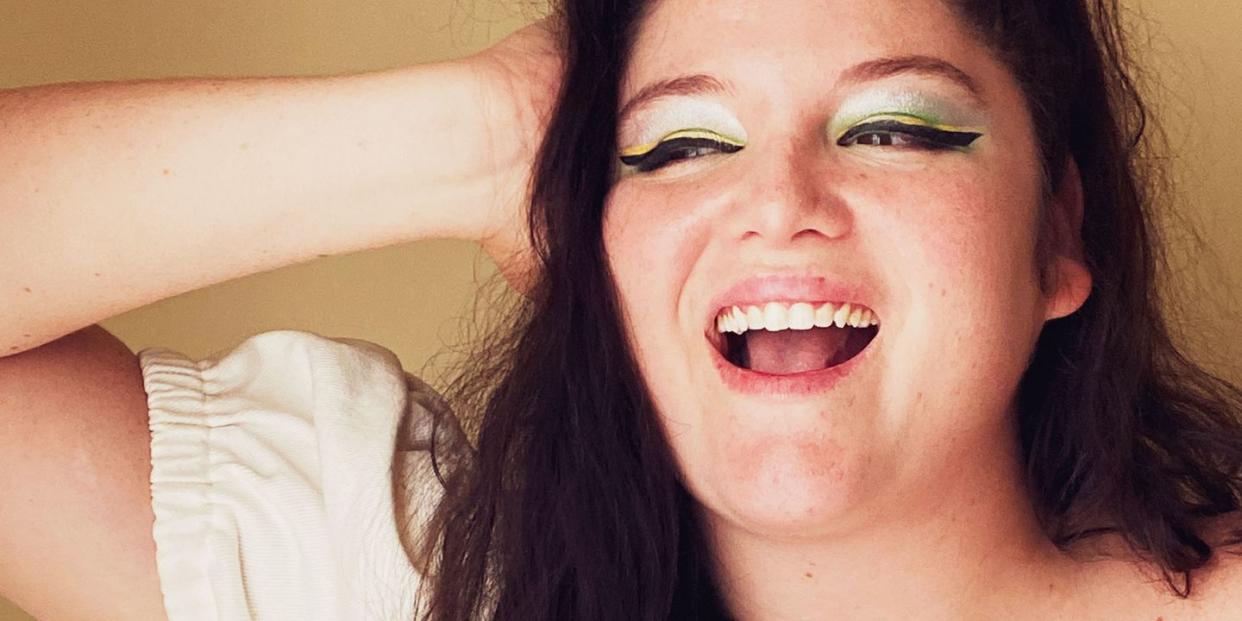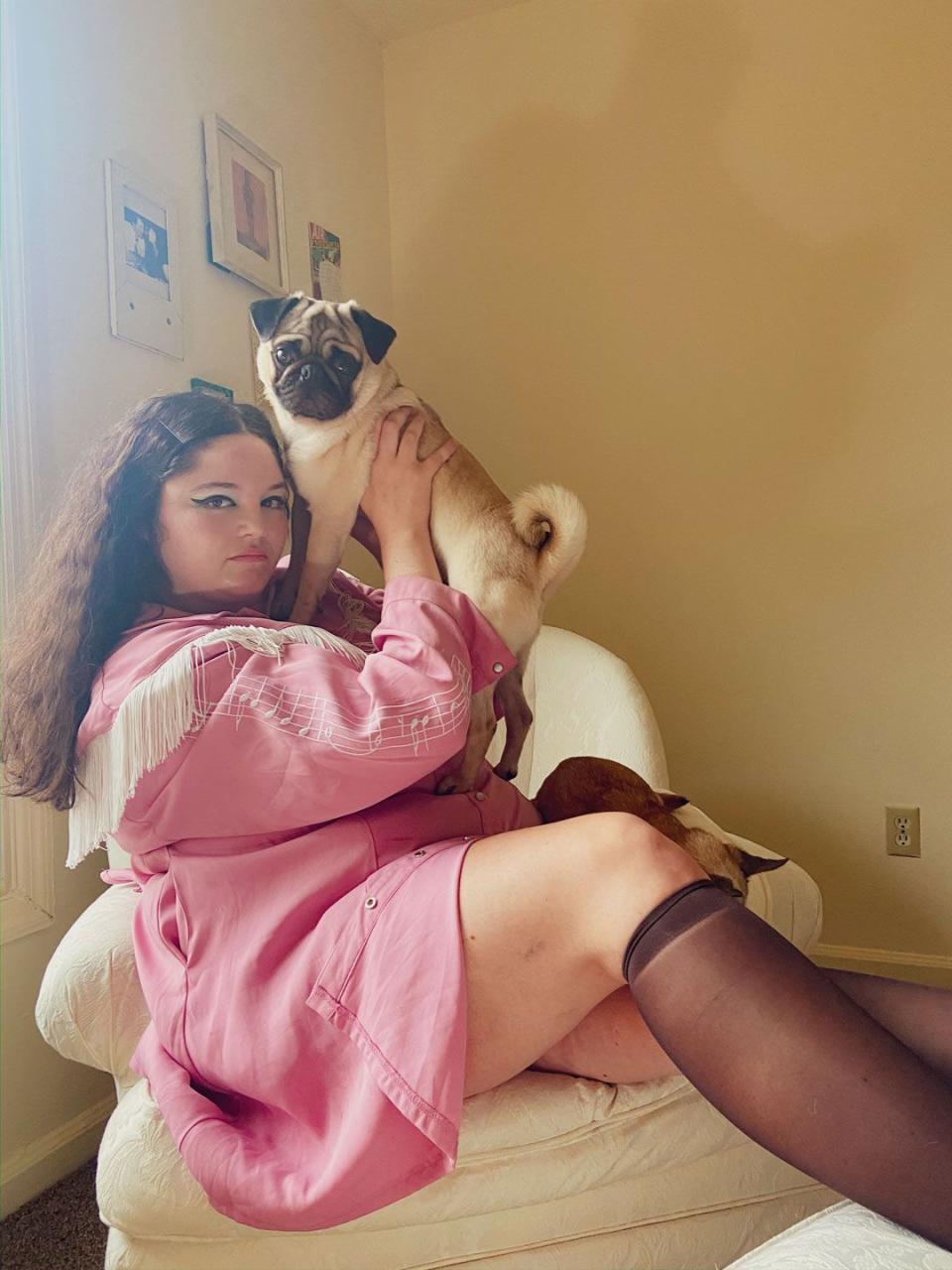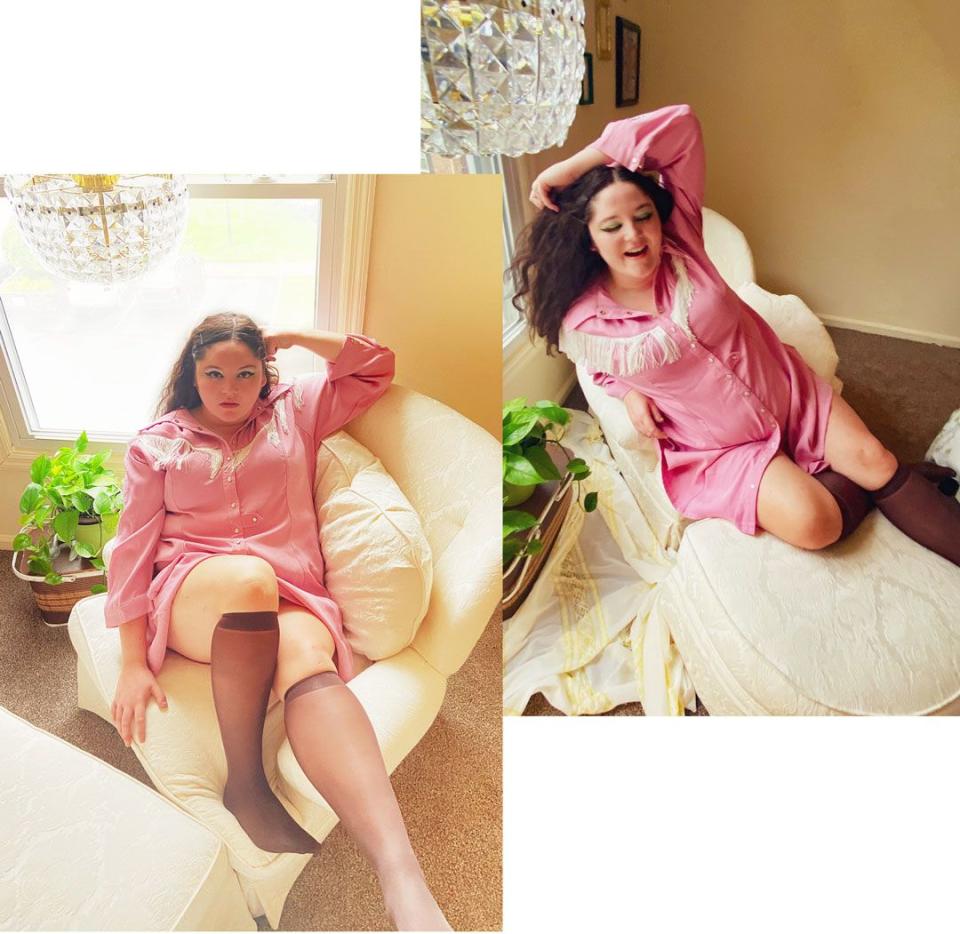Meg Stalter, Uninterrupted

If you've been online in the past year, you've likely seen a Meg Stalter video, or recieved one in a DM, or you've seen her name bandied around as a soothing comedy balm for a scathing grease fire of a year. Her front-facing comedy features Stalter cycling through a stable of outrageous, high-energy, low-self-awareness Midwestern underdogs, often in impeccable eyeshadow that lands somewhere between clown and hot clown. They're funny on their face, but their chaotic energy—the energy of someone who can't see that their own life is blowing up, let alone that the world is—offers a brief escape. What if 2020 were still 2020, but you were just blissfully, narcissistically unaware? What a way to live!
It's a type of person that Stalter understands because, well, there but for the grace of God…. When Stalter was in high school in suburban Ohio, she was the shy kid in the classroom. She didn't have many friends and constantly felt "deathly nervous" in class. She was hardly, Stalter would tell you herself, anyone's pick for Prom Queen. But in the drama department, she was the "Queen Freak." Nobody from her usual classes was in drama club, and so amongst her people she became a whole different Meg: giddy, goofy, loud, practically "shining," as Stalter recalls. A consummate, you-just-can't-turn-her-off kind of performer. Some might say an outrageous, high-energy, low-self-awareness Midwestern underdog.
And even as "Queen Freak," she couldn't get one damn lead role. Not even supporting. A few lines buried in the chorus, maybe. Once, she was the understudy for the lead in their school production of Noël Coward's classic comedy Blithe Spirit. Stalter took her understudy job seriously. She researched the crap out of that role. Not only that, whenever she was stuck in the chorus of any play, she would spend her time in Siberia, stage left, researching everybody's roles. Weeks of research. Read the script up and down. Found every recording she could find, watched ever movie adaptation. "I would just want to be the lead so bad," she says. And then her time finally came! The lead had to drop out. She can't remember why, but who cares, it was Meg's time to shine! She waited with anticipation for the drama teacher to come and finally give her what she craved, what she'd earned. Instead, the teacher sent another kid, her star student, backstage to break it to Stalter: they weren't going to give her the part after all. "That's just the business," he said smugly.

"I was literally the understudy!" says Stalter, howling with laughter as she retells the story. "They did everything they could do to keep me out of that play." She's on Zoom, speaking from her mom's house back in Ohio, where she'd returned to ride out the COVID-19 pandemic with her family. Here, she reminisces about a youth spent fumbling for greatness—a greatness she apparently had no business believing in so steadfastly, not in drama club or in the improv classes she would later take.
"I always thought I was good. I always thought I was amazing," says Stalter. "I always thought, Oh my God everyone in the class is going to be like, 'She's so good!'" She was really bad. She took a Shakespeare improv class, but she didn't know any Shakespeare. "So I thought you were just supposed to poison people," she says. Eventually, her improv teacher told her that if she didn't stop killing everyone in the scene, she would have to leave the class. Even the reviews from friends who came to see her shows were less than glowing. "You were the person in the show who made everyone think, This is uncomfortable," one of them told her.
Yet Stalter discovered that in every show, she was the one who stood out. Even when she was bad, she especially stood out. So she just had to learn to stand out for being good. She wanted to move to New York or Los Angeles, where the action was, where she could get a proper education. But Stalter couldn't afford it, and decided instead on either Chicago (birthplace of Second City and Upright Citizens Brigade) or Austin (a cousin once told her it had a great improv scene, something she never heard from anyone else ever again). In Chicago, everything clicked. In Chicago, you didn't just have to be a stand-up. (She'd tried it and felt the scene didn't accept her.) You didn't just have to do improv. (It goes without saying that she wasn't making the cut for any improv troupes.) But you could be all that and more. Or you could be something else entirely. You didn't have to fit into one box. You could let your Queen Freak flag fly.
"I had this vision of myself and I guess it was different from what other people saw," says Stalter. "But I was finally able to get that vision out there, just doing what I thought was really funny. That's when it finally worked, when I was not trying to fit in."
Stalter finally moved to New York last August. There she began to perform live at least three nights a week, sometimes as many as six. She hit every Brooklyn comedy haunt she could—The Bell House, Union Hall, Littlefield. And just when she found everything she was looking for—a welcoming comedy scene, a receptive audience, venues that wouldn't throw her off stage for grossly misunderstanding Shakespeare—a pandemic swept through New York and shut everything down, and Stalter's comedy career made a round trip return to Ohio.
But somewhere around 2018, Stalter had started a Twitter account. She approached it, like everything else, with sheer nerve. She would tag friends who had followers and tweet, It's your turn to retweet me today. Congratulations! You won! "I just bullied people into getting me followers," she says. Around that time, she started posting videos on a YouTube channel called The Meg Stalter Show, a faux-talk show that resembles both visually and spiritually the episode of Seinfeld where Kramer assembles the The Merv Griffin Show set in his apartment. Soon she was cross-posting short front-facing character videos on YouTube, Twitter, and Instagram. And by the time she was hustling for stage time in New York, she already had a dedicated online following on Twitter and Instagram in excess of 100,000 fans.
The first video of Stalter's to go viral came on August 25, 2019 under the caption "My audition for the girl in the movie who the guy almost hooks up with before he goes after the love of his life." Embedded was a 50-second lo-fi video of Stalter in a generic-looking school varsity sweater and a cheap blonde wig that makes her scalp itch. She sits on a bed and briefly starts to pull the sweater over her head, pauses, and then delivers a monologue to an unseen boy about how she's not the one for him, how he should go after the girl he's meant to be with, don't worry, she'll be okay, promise (she's a hot blonde after all). It was such a perfect distillation of a Hollywood "type" that it's hard to believe an early-in-her-career Margot Robbie didn't deliver those exact lines on screen at some point.
Stalter's bite-sized character studies are sometimes improvised from a loose outline, sometimes read word-for-word from a script she'd dashed off in a matter of minutes. Most follow a "the girl who..." structure, lampooning broad cliches with a kernel of pathos at their center, which make them so relatable, whether we want to admit it or not. ("Your aunt who just now realized we should quarantine" being a particularly skewering snapshot of early pandemic denial.)

In quarantine and with nowhere much to go, Stalter expanded her bits into hours-long interactive Instagram Live performances. They gave her something to do, sure, but also helped her retain a sliver of comedy club-hopping normalcy. In the first months of the pandemic, the freewheeling wackiness of her characters on the livestreams stood in contrast to the anxious viewers who tuned in. One night, Stalter went live as a woo-woo fortune teller and ended up fielding very real, very raw questions from fans—people who had lost their jobs, a high school grad anxious about starting college (who Stalter still keeps in touch with)—all struggling with what the future held. "This was pretty early into quarantine, so I think people were especially shaken up," says Stalter. Her fortune teller tried to reassure them while also making them laugh, and at one point Stalter dropped the act and just reassured viewers herself. "We're all connecting with each other online because that's all we have right now," she tells me.
When the killings of George Floyd, Ahmed Arbery, and Breonna Taylor ignited nationwide protests, Stalter watched from Ohio, particularly moved by the crowds chanting "Black Lives Matter" in New York, where she'd just left her new life behind. She couldn't find protests of that scale nearby, and worried for her parents' health even if could find and attend one, so she felt increasingly antsy to do something. Then an idea struck.
When she'd left Brooklyn, she'd thrown a few choice pieces of wardrobe in her luggage—Stalter tends to shop for clothes she can wear in real life and also on-stage ("Oh, that's a Megan character," she'd think)—and started to dig through them. Amongst what she'd packed was a baseball cap with rhinestones that spelled out SOCCOR MOM. It had considerably less IRL versatility, but screamed "that's a Megan character." And indeed it became the basis of the opening character in Little Miss Ohio, a 42-minute movie Stalter shot with her artist brother, a frequent collaborator, videographer, and somewhat unwitting co-host on Stalter's Confronting Demons With Megan Stalter podcast.
Shot largely outside, the movie is like a sizzle reel of "Megan characters" running amok in casino parking lots, fast food drive-throughs, and all-but-abandoned suburban neighborhood. Stalter's brother shot it and appeared in a cameo, and Stalter helped edit. She found archival footage of the 1963 Miss America pageant, in which Miss Ohio took home the crown even as the commentator negs her for once being "a chubby, 150-pound Sandusky, Ohio teenager." It was the perfect title card opener, and partly the inspiration for the movie's name. Stalter published Little Miss Ohio online for free and encouraged viewers to donate to the Okra Project, a New York-based organization that provides food, resources, and aid to Black trans people. It brought in $6,000 and counting in donations. Statler felt like she'd taken back a bit of control, as well as some relief in knowing that her fans are the kind that will step-up in some small way times of reckoning. "Some people online find out that their followings suck," says Stalter. "I found out that mine was smart and funny and kind."
Stalter is still sticking it out in Ohio, creating content with her brother, who she swears up and down is actually funnier than she is, though he stays mostly behind the camera. Now, he's found happiness in taking the content mill from one-woman-shot to a family affair. Most days, Stalter asks, "Which character do I feel like doing today?" and might end up with her brother filming her in her bra in the backyard, rambling like a lunatic for God knows how many people online. "He really likes to film," says Stalter, before the image really crystallizes in her head, and she starts to laugh. "But maybe not me in a bra."
You Might Also Like

